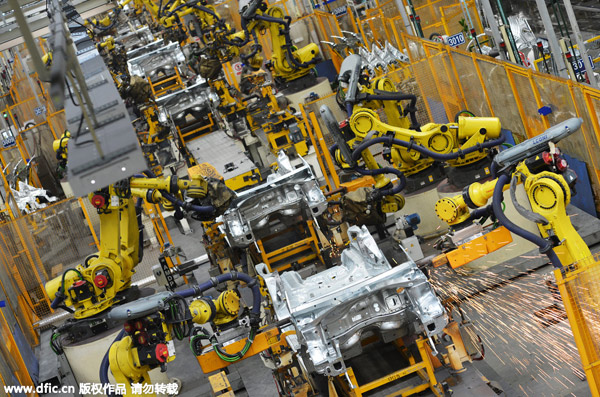Manufacturing hub starts work on first zero-labor factory
Updated: 2015-05-03 14:22
By Chen Bei(chinadaily.com.cn)
|
||||||||
 |
|
Robot arms weld car parts at an auto plant of Dongfeng Peugeot Citroen Automobile Co in Wuhan city, central China's Hubei province, Sept 24, 2014. [Photo/IC] |
A manufacturing hub in South China's Guangdong province has begun constructing the city's first zero-labor factory, a signal that the local authorities are bringing into effect its "robot assembling line" strategy.
Dongguan-based private company Everwin Precision Technology Ltd is pushing toward putting 1,000 robots in use in its first phase of the zero-labor project, China National Radio reported. It said the company has already put first 100 robots on the assembly line.
"The 'zero-labor factory' does not mean we will not employ any humans, but what it means is that we will scale down the size of workers by up to 90 percent," said Chen Qixing, the company's board chairman.
After the work on smart factory started, Chen predicted that instead of 2,000 workers, the current strength of the workforce, the company will require only 200 to operate software system and backstage management.
Under the current pressure of labor shortage, calls to use smart robots in cities around the Pearl River Delta (PRD), including Foshan and Dongguan, are becoming louder.
"It is necessary to replace human workers with robots, given the severe labor shortage and mounting labor costs," said Di Suoling, head of Dongguan-based Taiwan Business Association.
Manufacturers in the PRD have been hit by a shortage of an estimated 600,000 to 800,000 workers, according to data released after the Spring Festival in February.
Tens of thousands of migrant workers had earlier gone back home to inlands for a family get-together and some of them decided to settle down in their hometown where the living costs are much less than the coastal cities.
The country also faces the problem of an increasing number of aging migrant workers.
Although the number of migrant workers in China continued to grow in 2014, the rate of increase for the group has fallen consecutively for four years, and their average age is on the rise, according to a report released by the National Bureau of Statistics.
The year-on-year growth rate has been declining since 2010. From 2010 to 2013, the figure stood at 5.4 percent, 4.4 percent, 3.9 percent and 2.4 percent, respectively.
Around 43.5 percent of migrants in 2014 were over 40 years old, compared to 34.1 percent in 2010, and 30 percent in 2008, government data show.
"In the future, the percentage of migrant workers under 40 will further decrease, and this is a warning for China's labor-intensive manufacturing industry," said Li Zuojun, a senior researcher at the Development Research Center of the State Council, according to Economic Daily.
Faced with the dire situation of a shrinking workforce, economists suggest that China should upgrade its technology and largely use smart robots.
Guangdong authorities said in March that they will invest 943 billion yuan ($152 billion) to replace humans with robots within three years.
The local government will push for application of robots in 1,950 companies across the province and plans to build two advanced industrial bases for robot production by the end of 2017.
 New exhibition by Fondazione Prada offers new perspective on originality and imitation
New exhibition by Fondazione Prada offers new perspective on originality and imitation
 Mayweather beats Pacquiao by unanimous decision
Mayweather beats Pacquiao by unanimous decision
 Newborn British princess makes first appearance with royal
Newborn British princess makes first appearance with royal
 Quake-hit China-Nepal highway cleared
Quake-hit China-Nepal highway cleared
 Highlights of Milan Expo 2015
Highlights of Milan Expo 2015
 Twins festival kicks off in Yunnan
Twins festival kicks off in Yunnan
 Chinese rescuers work on outskirts of Kathmandu, Nepal
Chinese rescuers work on outskirts of Kathmandu, Nepal
 Mother throws million-yuan fashion show for daughter's birthday
Mother throws million-yuan fashion show for daughter's birthday
Most Viewed
Editor's Picks

|

|

|

|

|

|
Today's Top News
More speculation in China's market as it's new
Manufacturing hub starts work on first zero-labor factory
New York City police officer shot in head while conducting patrol
Putin ratifies east-route gas pipeline agreement with China
Britain has a new princess and eagerly awaits her name
UK's Duchess Kate gives birth to a daughter
Nepal President expresses gratitude for China's quake relief work
Beijing allows guide dogs
on subway
US Weekly

|

|






